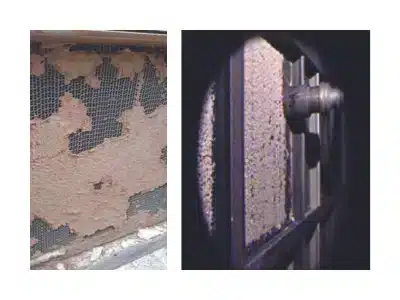SCR Fouling Solved; Production Derates Eliminated
High Pressure Drops Contribute to Production Derates, Poor NOx Removal, and Insufficient Ammonia Mixing.

Lost production impacted customer demands for Hydrogen supply and led to a loss of $1M due to a forced shutdown to clean the SCR in order to restore production rates and meet demand. Combined with the costs of lost production during derates, shortened catalyst life, and excessive ammonia usage, this SCR fouling was documented to total an estimated $3M+ annual cost.
This fouling of the SCR face was caused by a combination of refractory fibers and dust that would deposit on the SCR face
and block gas flow, much like lint will accumulate on the dryer lint trap and limit flow. This material accumulation was so severe that the plant would often be forced to derate within 2-3 months of operation.
Comprehensive Approach to SCR Efficiency
Integrated Global Services (IGS) was contracted to provide a comprehensive system to eliminate the cost and efficiency
impacts of this fibrous material fouling the SCR. This solution was implemented in two stages: a plan for immediate relief and a long term system to eliminate future catalyst fouling altogether.
Instant Relief: IGS HotVac
In order to eliminate forced turnarounds to vacuum this material off the SCR face, IGS utilized a patented online vacuuming process, IGS HotVac, to eliminate the excessive pressure drop across the SCR. While the unit was in operation, HotVac access ports were installed and online vacuuming was performed, relieving the pressure drop and allowing the furnace to return to full load.
Although this was an excellent tool to eliminate the high pressure drop and restore production without requiring a turnaround, this did not prevent future SCR fouling and was required multiple times per year due to the severity of the accumulation in this application.

Protect the SCR: Fine Particle Filtration Screens and Online Cleaning System
Critical to the long-term prevention of SCR fouling, the IGS patent-pending dual stage filtration screen and online cleaning system was installed directly upstream of the SCR catalyst. This screen system is designed to capture the fibrous material in the gas stream prior to it reaching the catalyst face, much like a lint trap captures material in dryer ducting. Once captured on the screen face, the air cannon online cleaning system removes the material from the screen and pushes it down into a collection area out of the flue gas path where it can later be removed. By preventing the fibrous material from fouling the catalyst, this ensured proper flow distribution, minimized pressure drop, and extended the catalyst life.

Improving System Efficiency: Ammonia Mixing System
During the CFD design phase of this project, it was identified that the ammonia mixing also needed to be improved. The layout of this system allowed IGS to design and incorporate a specialized ammonia mixer into the screen system. While the
screen helps to normalize the flue gas distribution, the mixing system attached to the downstream side of the screen material creates turbulent flow to increase the ammonia distribution before flue gas enters the SCR catalyst. This dramatically improved the RMS distribution at the catalyst face.

Reduction of Fibrous Material: Refractory Encapsulation
To supplement the screen system, prolong the refractory life, and reduce convection section fouling, the IGS refractory encapsulation system was also installed. This technology includes surface preparation of the refractory and a multi-phase coating designed to rigidize the refractory surface and fully encapsulate the material. Often, this does not eliminate all of the fibrous material in the flue gas, but it does significantly reduce the rate of accumulation on downstream equipment while adding significant life to the refractory itself.
Guaranteed Solution: 95% Clean SCR Guarantee
Installation of the full comprehensive SCR system scope including fine particle screen system, hot vacuum service access ports, and refractory encapsulation resulted in IGS providing the industry leading 95% Clean SCR Guarantee.

Results: SCR Fouling Eliminated & SCR Efficiency Improved
Since coming online in Spring 2021, the plant has not had any production derates or forced shutdowns related to the SCR. The fine particle screen system and refractory encapsulation have eliminated the need for online vacuuming, although the access still is available in the event of a system upset. Online inspections have shown minimal material accumulation on the SCR catalyst face. The screen and mixing system also resulted in a 15% RMS distribution improvement, resulting in more operational flexibility, less ammonia slip, and ammonia savings.
Return on Investment in Less Than Three Months
The IGS comprehensive SCR solution has eliminated the effects of fibrous material on the SCR, while improving ammonia mixing, in turn saving millions of dollars annually. Comparing the elimination of system derates to the turnkey cost of the
installation, the ROI was recognized in less than 3 months of operation.

Free consultation with an IGS Subject Matter Expert
IGS is here to provide information, answer questions and create an effective solution for your needs.
